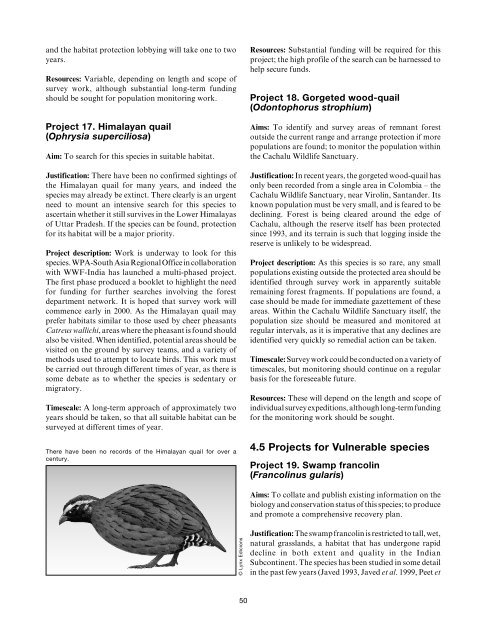Partridges, Quails, Francolins, Snowcocks, Guineafowl, and Turkeys
Partridges, Quails, Francolins, Snowcocks, Guineafowl, and Turkeys
Partridges, Quails, Francolins, Snowcocks, Guineafowl, and Turkeys
Create successful ePaper yourself
Turn your PDF publications into a flip-book with our unique Google optimized e-Paper software.
<strong>and</strong> the habitat protection lobbying will take one to two<br />
years.<br />
Resources: Variable, depending on length <strong>and</strong> scope of<br />
survey work, although substantial long-term funding<br />
should be sought for population monitoring work.<br />
Project 17. Himalayan quail<br />
(Ophrysia superciliosa)<br />
Aim: To search for this species in suitable habitat.<br />
Justification: There have been no confirmed sightings of<br />
the Himalayan quail for many years, <strong>and</strong> indeed the<br />
species may already be extinct. There clearly is an urgent<br />
need to mount an intensive search for this species to<br />
ascertain whether it still survives in the Lower Himalayas<br />
of Uttar Pradesh. If the species can be found, protection<br />
for its habitat will be a major priority.<br />
Project description: Work is underway to look for this<br />
species. WPA-South Asia Regional Office in collaboration<br />
with WWF-India has launched a multi-phased project.<br />
The first phase produced a booklet to highlight the need<br />
for funding for further searches involving the forest<br />
department network. It is hoped that survey work will<br />
commence early in 2000. As the Himalayan quail may<br />
prefer habitats similar to those used by cheer pheasants<br />
Catreus wallichi, areas where the pheasant is found should<br />
also be visited. When identified, potential areas should be<br />
visited on the ground by survey teams, <strong>and</strong> a variety of<br />
methods used to attempt to locate birds. This work must<br />
be carried out through different times of year, as there is<br />
some debate as to whether the species is sedentary or<br />
migratory.<br />
Timescale: A long-term approach of approximately two<br />
years should be taken, so that all suitable habitat can be<br />
surveyed at different times of year.<br />
There have been no records of the Himalayan quail for over a<br />
century.<br />
Resources: Substantial funding will be required for this<br />
project; the high profile of the search can be harnessed to<br />
help secure funds.<br />
Project 18. Gorgeted wood-quail<br />
(Odontophorus strophium)<br />
Aims: To identify <strong>and</strong> survey areas of remnant forest<br />
outside the current range <strong>and</strong> arrange protection if more<br />
populations are found; to monitor the population within<br />
the Cachalu Wildlife Sanctuary.<br />
Justification: In recent years, the gorgeted wood-quail has<br />
only been recorded from a single area in Colombia – the<br />
Cachalu Wildlife Sanctuary, near Virolín, Sant<strong>and</strong>er. Its<br />
known population must be very small, <strong>and</strong> is feared to be<br />
declining. Forest is being cleared around the edge of<br />
Cachalu, although the reserve itself has been protected<br />
since 1993, <strong>and</strong> its terrain is such that logging inside the<br />
reserve is unlikely to be widespread.<br />
Project description: As this species is so rare, any small<br />
populations existing outside the protected area should be<br />
identified through survey work in apparently suitable<br />
remaining forest fragments. If populations are found, a<br />
case should be made for immediate gazettement of these<br />
areas. Within the Cachalu Wildlife Sanctuary itself, the<br />
population size should be measured <strong>and</strong> monitored at<br />
regular intervals, as it is imperative that any declines are<br />
identified very quickly so remedial action can be taken.<br />
Timescale: Survey work could be conducted on a variety of<br />
timescales, but monitoring should continue on a regular<br />
basis for the foreseeable future.<br />
Resources: These will depend on the length <strong>and</strong> scope of<br />
individual survey expeditions, although long-term funding<br />
for the monitoring work should be sought.<br />
4.5 Projects for Vulnerable species<br />
Project 19. Swamp francolin<br />
(Francolinus gularis)<br />
Aims: To collate <strong>and</strong> publish existing information on the<br />
biology <strong>and</strong> conservation status of this species; to produce<br />
<strong>and</strong> promote a comprehensive recovery plan.<br />
© Lynx Edicions<br />
Justification: The swamp francolin is restricted to tall, wet,<br />
natural grassl<strong>and</strong>s, a habitat that has undergone rapid<br />
decline in both extent <strong>and</strong> quality in the Indian<br />
Subcontinent. The species has been studied in some detail<br />
in the past few years (Javed 1993, Javed et al. 1999, Peet et<br />
50

















